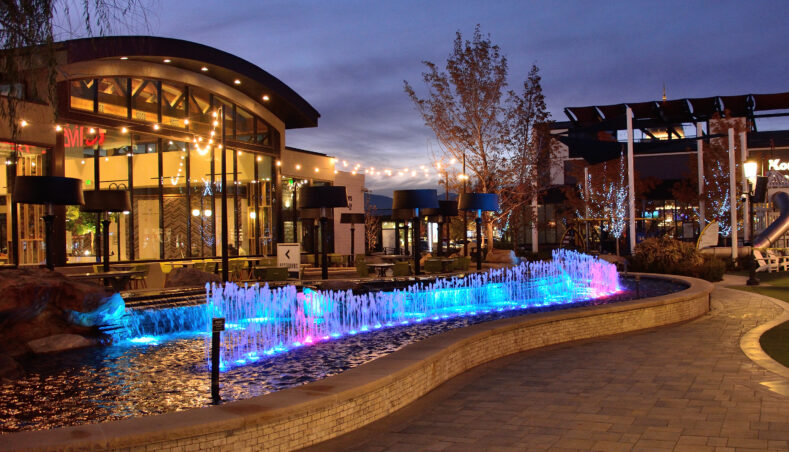Hot Spots: 3 U.S. Markets Redefining Retail & Entertainment Development
Posted in Insights -

The landscape of retail and entertainment is evolving rapidly in 2025. Consumers increasingly seek experiences over transactions, pushing developers to create spaces that seamlessly blend shopping, dining, entertainment, and community engagement. Across the U.S., certain markets are emerging as incubators for innovation in mixed-use development. Here are three leading markets – and strategies developers can use to capitalize on them:
Beaverton, Oregon: Suburban Revival with Purpose
Beaverton is redefining suburban retail by embracing purpose-driven, community-oriented developments. The Walker Center, home to Oregon’s largest REI Co-Op, exemplifies this trend. Beyond traditional retail, the center now houses tenants such as Kaiser Permanente and Blick Art Materials, attracting customers seeking wellness, lifestyle, and creative experiences. Local restaurants and boutique fitness studios have flourished alongside these tenants, creating a more holistic environment.
Developers can take advantage of this shift by designing mixed-use spaces that prioritize community engagement. Key strategies include:
- partnering with local institutions to provide programming, events, or pop-up experiences that encourage repeat visits. In fact, programming may be the most important aspect in retail and entertainment design, and it often gets overlooked. Even great amenities are not enough without a significant programming effort to keep things fresh;
- incorporating wellness-focused amenities such as green spaces, fitness areas, and flexible gathering spaces;
- attracting tenants with a strong social or environmental mission, which resonates with today’s conscious consumers.
By blending commerce, community, and purpose, Beaverton’s developments are showing how suburbs can thrive in an era dominated by experience-driven retail.
Tampa, Florida: Sports and Entertainment Integration
Tampa is emerging as a dynamic market for sports-centered mixed-use development. Plans for a new stadium at the 100-acre Dale Mabry campus of Hillsborough Community College (HCC) highlight a trend of integrating sports venues with surrounding retail, residential, and entertainment offerings. The proposed location, near Raymond James Stadium and major employment districts, could serve as a multi-functional hub that attracts both fans and local residents year-round.
Developers can capitalize on this trend by creating flexible, multi-use venues that host live events while providing retail, dining, and entertainment options. Strategies include:
- designing spaces for year-round activation, not just game days, to drive steady foot traffic;
- incorporating technology such as AR/VR experiences, mobile engagement apps, or interactive fan zones;
- partnering with sports teams, entertainment brands, or local institutions to increase visibility and attract diverse audiences.
Tampa demonstrates how blending sports, entertainment, and retail can transform underutilized areas into thriving, destination-driven districts.
Austin, Texas: Urban Expansion with Entertainment Focus
Austin’s southeast corridor is seeing transformative development with The Row, a 314-acre mixed-use project. Previously known as Velocity, the project integrates residential, hotel, retail, and entertainment components, creating a vibrant urban destination. Austin’s strong population growth, influx of tech companies, and dynamic cultural scene make it ideal for developments that cater to both residents and visitors.
Urban expansion areas like Austin benefit from integrated planning and long-term vision. Developers can maximize impact by:
- prioritizing pedestrian-friendly design and connectivity to transit, nearby districts, and public spaces – important because Austin’s transportation infrastructure has been strained by the metro’s growth over the past 20 years, creating traffic issues;
- combining residential units with experiential retail, restaurants, and entertainment to create a 24/7 destination;
- offering flexible venues that can adapt to emerging trends, such as e-sports arenas, live performance spaces, or pop-up activations.
The Row exemplifies how urban mixed-use projects can become lifestyle hubs that attract diverse tenants and visitors while driving long-term value.
These three markets illustrate how retail and entertainment are being reimagined in 2025. Developers can capitalize by emphasizing mixed-use, experience-driven design; partnering with lifestyle, wellness, and entertainment brands; integrating technology and immersive experiences to enhance engagement; and aligning developments with community needs and local culture.
By staying ahead of these trends and designing with both purpose and flexibility, developers can create spaces that attract consumers, tenants, and investors alike – ensuring long-term success in a rapidly changing retail and entertainment landscape.
Featured Articles
- Leading With Heart: Why Giving Back Is Good Business
- Hot Spots: 3 U.S. Markets Redefining Retail & Entertainment Development
- Bringing Out the Best: Leadership That Elevates
- From Spas to Speakeasies: Amenities Defining Today’s Private Estates
- Getting to Know Devin Schumacher, Director of Field Operations